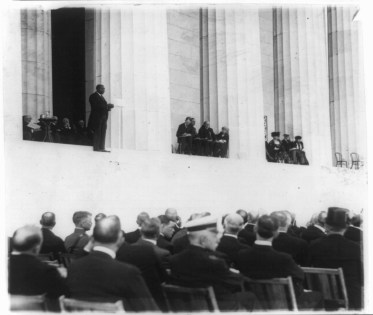By Kaleena Fraga
Ninety-six years ago today a crowd gathered in Washington D.C. to witness the dedication of the Lincoln Memorial. Present were former president William Howard Taft, presiding as Chief Justice, current president Warren G. Harding, and Abraham Lincoln’s son, Robert Todd Lincoln. And, of course, Abraham Lincoln himself, immortalized in stone and looming almost 100 feet over the three men.
Between the three of them, the men comprised over fifty years of presidential history, and a resume nearly as tall as the memorial itself. Robert Lincoln had been twenty-two when his father was assassinated. Although he didn’t follow in his footsteps to the presidency, Robert Lincoln had served as U.S. Ambassador to Great Britain, as the Secretary of War under two presidents, and as the chairman and president of the Pullman Railroad Company. He held the dubious honor of being present for two other presidential assassinations–those of Presidents Garfield and McKinley–which made him acknowledge “a certain fatality about the presidential function when I am present.” Still, no one at the dedication that day seemed nervous about his presence.
 Dr. Robert Moton, a civil rights activist, gave the keynote address. Although he spoke to a largely segregated audience, Moton pushed for equality for all races. The previous year, Moton had written President Harding a letter with suggestions on how to improve race-relations. His crusade to hire an all-black staff at the Tuskegee Veterans Administration Hospital for African-American WWI veterans had provoked death threats from white supremacists, although Harding endorsed the idea. Moton’s presence on stage, then, seemed to be both an explicit realization of Lincoln’s promise, and an implicit nod of support from the current administration. Yet he also represented the work to be done–despite giving the keynote, Moton was not allowed to sit on the speaker’s platform.
Dr. Robert Moton, a civil rights activist, gave the keynote address. Although he spoke to a largely segregated audience, Moton pushed for equality for all races. The previous year, Moton had written President Harding a letter with suggestions on how to improve race-relations. His crusade to hire an all-black staff at the Tuskegee Veterans Administration Hospital for African-American WWI veterans had provoked death threats from white supremacists, although Harding endorsed the idea. Moton’s presence on stage, then, seemed to be both an explicit realization of Lincoln’s promise, and an implicit nod of support from the current administration. Yet he also represented the work to be done–despite giving the keynote, Moton was not allowed to sit on the speaker’s platform.
(As for Taft and Harding, curious readers can learn more about them here and here).
The architect Henry Bacon designed the memorial, which he modeled after the Pantheon. Bacon felt that the man who had saved democracy deserved a memorial reminiscent of the birthplace of democracy. It featured 36 pillars to represent the 36 states that Lincoln had reunited; texts of the Gettysburg Address and Lincoln’s second Inaugural Address; and, of course, the looming figure of Lincoln, designed by David Chester French.
Harding, the child of abolitionists, accepted the dedication from Taft. He closed the ceremony by saying:
“This Memorial is less for Abraham Lincoln than those of us today, and for those who follow after.”
They were prescient words–the Lincoln Memorial would go on to be a gathering place for people seeking equality and justice.

Fascinating & very interesting piece; and, as usual, very well-written; I would like to experience the Lincoln Memorial one day!
LikeLiked by 1 person